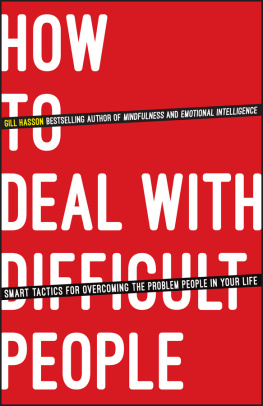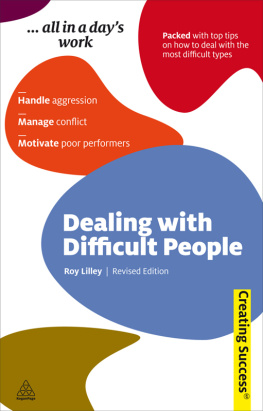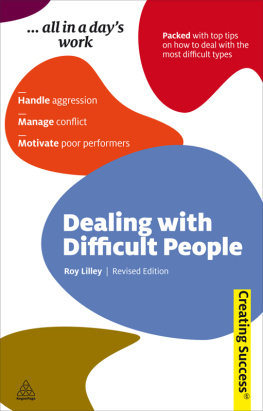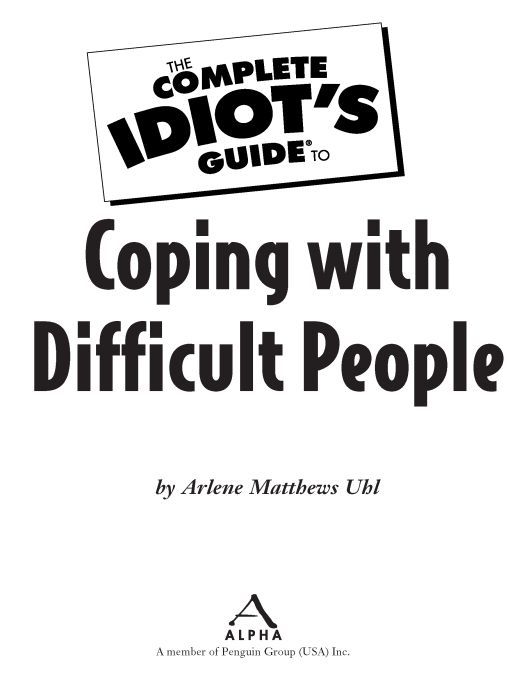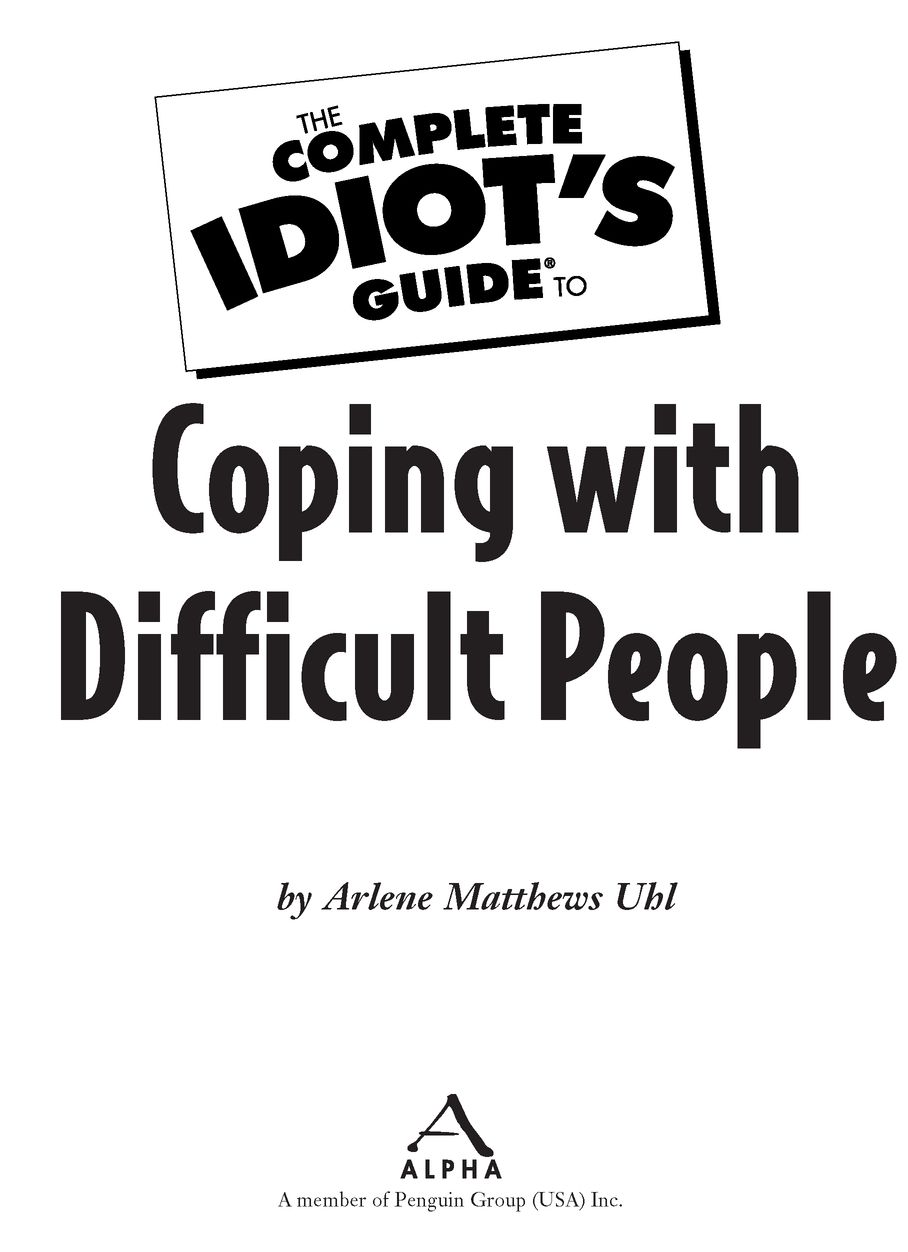Table of Contents
Introduction
Will Rogers, the renowned American humorist, famously said, I never met a man I didnt like. He never would have needed a copy of this book. For the rest of us, however, its essential to have strategies in place for dealing with people who annoy us, thwart us, and frustrate us. We say such people drive us crazy, but the truth is they can only do so if we let them do the driving. Its time to take control of the wheel.
Ah, but what can be done with difficult people? Woody Allen suggested immersing them in warm gravy, but that sounds messy. The hero of Shakespeares Taming of the Shrew used starvation and sleep deprivationbut that sounds like grounds for a lawsuit. Henry VIII simply beheaded those who displeased him, but this approachin a rather positive developmenthas gone out of fashion.
As it happens, the sanest, wisest thing to do with difficult people is to learn to cope with them: the selfish and self-centered, the rude and the crude, the overtly and passively aggressive, the naysayers and nitpickers, the mean and the menacing. In whatever environments we encounter difficult people, we have to learn to respond to them rationally, rather than reacting impulsively (which usually makes the situation worse) or letting them take advantage of us (which they all too quickly turn into a habit).
Thats the challenge, you see: managing our own behavior. The more we can develop and stick to a game plan for coping with tough people in tough situations, the better the results will be. The goal of this book is to help you develop that game planfor your work life, your private life, and your general out-and-about-in-the-world life.
Difficult people are everywhere. We cant wave a magic wand and make them disappear. But we can develop the emotional skills we need so that our encounters will seem almost magically transformed from the torturous to the tolerable.
How This Book Is Organized
This book is divided into six parts. Each will assist you with different aspects of dealing with difficult people.
Part 1, The ABCs of DPs, describes our modern epidemic of difficult people, tells us how to spot a chronically difficult individual, and offers some basic self-protective strategies.
Part 2, The Self-Absorbed, addresses the challenges of coping with self-centered people in the workplace, in personal relationships, and in public situations.
Part 3, The Controllers, tells how to regain control from controlling types in any setting. It looks at overt, demanding controllers as well as deceptive and covert types.
Part 4, The Obstructionists, will help you cope with the challenges of people who block your wayat work, at home, and in the world at largewith pessimism, perfectionism, irresponsibility, and indecision.
Part 5, The Truly Toxic, offers advice for coping with people who have crossed the line from difficult to dangerous or cruel. It offers strategies for avoiding victimization across a wide range of scenarios.
Part 6, Advanced Attitude Adjustments, will help you flex your skills by offering strategies for coping with combination types of difficult people as well as nice people who are having a difficult day. It also focuses on what we all can learn from the challenging people in our lives, and how we can make ourselves easier for others to get along with.
Coping Companions
Sidebars and margin notes have been placed throughout the chapters in this book to make it especially easy to begin getting a handle on managing the difficult people in your life right away. Within these text boxes, youll find various tips and nuggets of knowledge. There are four kinds of sidebars:
DP Disarmer
These savvy strategic maneuvers will help you avoid sticky interpersonal tangles and minimize the impact of potentially difficult people.
Manhole Ahead
These alerts will help you identify signs of problematic behaviors and prevent you from provoking difficult people into being even more difficult.
Tried and True Tactics
Here youll find anecdotes and advice from men and women who are learning to better cope with the challenging people in their lives.
definition
Look here for an elaboration of terms used in the text.
Trademarks
All terms mentioned in this book that are known to be or are suspected of being trademarks or service marks have been appropriately capitalized. Alpha Books and Penguin Group (USA) Inc. cannot attest to the accuracy of this information. Use of a term in this book should not be regarded as affecting the validity of any trademark or service mark.
Part 1
The ABCs of DPs
No doubt there have been difficult people around since prehistoric times, when we lived amidst much smaller populations. But in todays crowded, highly interconnected world its not so easy to avoid people who test our patience. Its also inadvisable to take a caveman approach and bop them over the head with a rock. This part explains why, more than ever, we need to cultivate emotional skills to manage our people-related frustrations. It introduces the four primary types of difficult people (DPs), and lays down some basic rules for self-protection.
Chapter 1
Theyre EverywhereOr So It Seems!
In This ChapterLearning cooperative and competitive instincts
Dealing with cities, civilization, and social stress
The unnerving effect of technology
Why avoidance wont solve things
How aggression backfires
Emotional intelligence to the rescue
Listen to what he did to me now!
Can you believe she said that?
I cant stand that guyhes driving me crazy!
We overhear these sorts of comments every day. Theyre certainly the kind I listened to for years as a practicing psychotherapist in New York City. Complaining about other people seems to have surpassed baseball as the national pastime.
Are more people more difficult now than ever before, or does it just seem that way? To learn the somewhat complex answer to that question, its a good idea to understand some fundamentals about human social interaction.
No Manor WomanIs an Island
Seventeenth-century English author John Donne is well known for these words: No man is an island, entire of itself; every man is a piece of the continent, a part of the main






